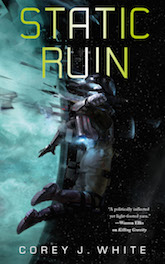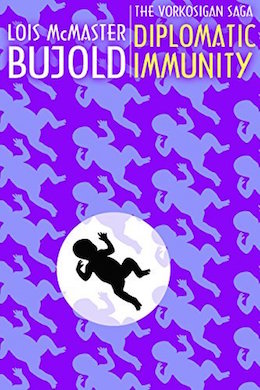Welcome back to the reread, where we are dealing with chapter 6 of Diplomatic Immunity. We get to go to the ballet! Nicol will be performing with the orchestra and has arranged a box so that Miles and Ekaterin can watch a performance with Bel and Garnet Five. I love this chapter because I love ballet. It’s one of the legacies of my time in Arizona—Ib Anderson’s production of Don Quixote was life-changing. I also love Quaddies, and this trip to the ballet is a crash course in Quaddie culture. What we saw back in Falling Free was the roots of this culture, born in a struggle in which the only options were freedom and annihilation. This, two centuries later, has clear links to that early history while celebrating contemporary Quaddie autonomy.
So first, I have to point out that Quaddie fashion is AMAZING. Bel is wearing an ensemble that deploys cuffs and slashing in a way that demonstrates the practicality of Tudor fashions in future-space. At least, that is my reading of the doublet and slashed trews with cuffs at the knee. The combination of colors and prints is thrilling—orange and blue, with stars on the sleeves. Nicol is in form-fitting black knits and filmy rainbow scarves, a vaguely goth fairy-princess look that I think must be stunning in free fall. Garnet Five is wearing black velvet with a white lace ruff. Her ensemble reminds me of Victorian mourning clothes. She’s also wearing an air cast on one of her lower arms—a reminder of the reason Miles is here. The dancers are wearing glittery ship knits, which is further proof, if anyone needed it, of my point about ship knits being the most versatile garments ever invented.
Although the focus of the evening is on art, there’s plenty of time for conversation about what’s on the forefront of everyone’s mind—love, and its natural consequence, which is babies. Miles came to this party to make Barrayar look open-minded and diplomatic, so he’s taken by surprise when Garnet Five says that she and Corbeau have talked about children and makes Bel show off their baby pictures. Quaddies and downsiders (which is what Quaddies call people with legs) can have children together using uterine replicators. They have to decide how many arms their children will have before the child can be conceived. Bel didn’t mention this to Miles when they talked about wanting to take the oath of citizenship and stay in the UFH permanently, possibly because Bel didn’t know that Miles is in the grip of besotted impending parenthood. I think if Bel had asked to leave ImpSec service to start a family, Miles would have caved. Bel’s pictures are approximations based on parental facial features because Bel and Nicol haven’t started their baby yet. They have, however, decided that their first child will be a Quaddie girl, so it sounds like Bel’s citizenship is the last stumbling block.
Garnet Five also explains Quaddie naming conventions. The first Quaddies each had a name and a numerical designation. When they escaped, they began a system of single, unique names which were tracked. After several generations there were waiting lists for popular names, so the Quaddies voted to allow name duplication if the name had a numerical suffix. When a person dies, their name number, if they had one, can be reused. Bel knows a Leo Ninety-nine, but most numerical designations are smaller. Garnet Five is one of eight Garnets currently living in the Union. Nicol doesn’t have a numerical designation because she is the only living Nicol.
The performance is not a single ballet, but a collection of short pieces—Miles refers to them as works, reflecting both artistic convention and the value the Quaddies place on work as an ideal. Quaddie dance uses the zero-g environment and takes advantage of the Quaddies’ ability to use multiple sets of hands. In the opening piece, dancers use their hands to create shifting formations while playing drums. It sounds INCREDIBLE—like a cross between Riverdance and synchronized swimming.
Buy the Book


Static Ruin
The highlight of the evening is an excerpt from the Quaddie ballet The Crossing, which tells the story of the Quaddie’s migration to Quaddiespace. I sincerely hope that this ballet includes a scene where a work crew uses an ice die to fabricate a vortex mirror. And in my head, it does! I imagine that it’s an incredibly challenging dance sequence and is complicated and expensive to produce, which is why the company isn’t performing The Crossing in its entirety this evening. Instead, they are presenting the pas de deux between Leo and Silver. Leo is danced by a Quaddie performer wearing false legs. Silver is danced by Garnet Five’s understudy. The performance uses apparatus that sound like they would be similar to a jungle gym if they were built in an environment with gravity. Silver is graceful and Leo is clumsy, like an engineer.
Back when the only song the Quaddies knew was about the colors of the rainbow (“He’s the color Quaddie that the spectrum gives!”) I assigned all of my favorite characters in Falling Free their own theme songs. Leo Graf got Tom Petty’s “Free Falling.” Silver’s was “America’s Sweetheart” by Elle King. I didn’t choose a love theme for them because Falling Free isn’t a nineties romantic comedy. The orchestra plays one for them here, but Diplomatic Immunity isn’t a romantic comedy either—Garnet Five invited Miles and Ekaterin to this performance to pursue an agenda. She wants Corbeau freed from jail and discharged from the Barrayaran military. Miles isn’t sure that their relationship will stand the test of time; Garnet Five and Corbeau have only known each other for two weeks, and they’re both young. Miles doesn’t want to encourage their relationship—leaving the Barrayaran military during a term of enlistment carries a number of legal risks—but he does acknowledge to himself that his feelings for Ekaterin were just as sudden and unexpected.
Miles also acknowledges the importance of representation. Quaddie culture celebrates the unique lives, experiences, and abilities of people with four arms (and no legs), and its art and history acknowledge the participation of downsiders in Quaddie communities. Miles and Ekaterin have been wondering if Corbeau and Bel can lead normal lives in Quaddiespace. They can if they want! And it will likely be easier for them than it is for Miles—maybe even easier than it is for Solian and Corbeau—on Barrayar.
Ellen Cheeseman-Meyer teaches history and reads a lot.










